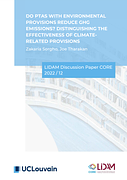Do PTAs with Environmental Provisions Reduce GHG Emissions? Distinguishing the Role of Climate-Related Provisions
July 20, 2022

Sorgho Z., Tharakan J. (2022) Do PTAs with environmental provisions reduce GHG emissions? Distinguishing the effectiveness of climate-related provisions. LIDAM Discussion Paper CORE 2022/12.